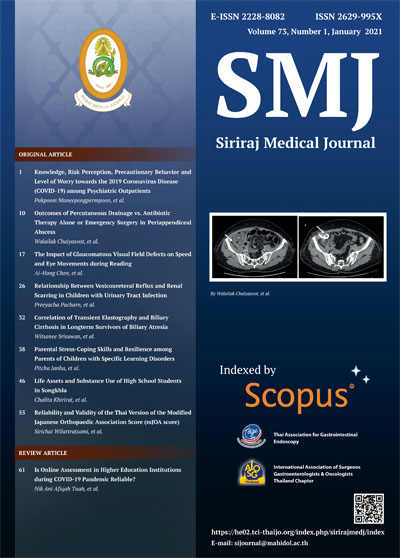Correlation of Transient Elastography and Progression of Cirrhosis in Longterm Survivors of Biliary Atresia
DOI:
https://doi.org/10.33192/Smj.2021.05Keywords:
transient elastrography, biliary atresia, liver stiffness measurementAbstract
Objective: This study aimed to use transient elastography (TE) to evaluate the correlation between liver stiffness measure (LSM) and functional status of native liver in longterm follow-up of pediatric patients with biliary atresia (BA).
Methods: Twenty cases of BA who had undergone hepatic portoenterostomy and had good initial outcome (total bilirubin < 2 mg/dL) were enrolled for a transient elastography. The LSMs derived from the study were analyzed with clinical and radiological parameters and endoscopic findings of esophageal varices.
Results: The median age at enrollment of the 20 cases was 8.4 years. Of the 20 cases, 15 were diagnosed as cirrhosis by ultrasonography and 9 had esophageal varices detected by an endoscopy. Parameters that were significantly associated with LSM were history of cholangitis, splenomegaly, cirrhosis and esophageal varices. Significantly higher LSM was found to be correlated with hyperbilirubinemia, transaminitis, alkaline phosphatasemia, thrombocytopenia and prolonged INR. On linear regression, LSM was significantly correlated with pediatric end-stage liver disease score at the r2 of 0.32 and correlated with the aspartate transaminase to platelet ratio index at the r2 of 0.70. The area under the receiver operating characteristic curve that reflected the performance of LSM in predicting esophageal varices was 0.97. At the cut-off value of 10.2 kPa, the sensitivity and specificity of LSM in predicting esophageal varices were 100% and 72.7%, respectively.
Conclusion: TE can be useful as a non-invasive, point-of-care evaluation of liver fibrosis in long term follow-up of BA. A high LSM indicates surveillance for esophageal varices in these patients.
References
2. Lee KJ, Kim JW, Moon JS, Ko JS. Epidemiology of Biliary Atresia in Korea. J Korean Med Sci. 2017;32(4):656-60.
3. Sanchez-Valle A, Kassira N, Varela VC, Radu SC, Paidas C, Kirby RS. Biliary Atresia: Epidemiology, Genetics, Clinical Update, and Public Health Perspective. Adv Pediatr. 2017;64(1):285-305.
4. Sangkhathat S, Patrapinyokul S, Tadtayathikom K, Osatakul S. Peri-operative factors predicting the outcome of hepatic porto-enterostomy in infants with biliary atresia. J Med Assoc Thai. 2003;86(3):224-31.
5. Wai CT, Greenson JK, Fontana RJ, Kalbfleisch JD, Marrero JA, Conjeevaram HS, et al. A simple noninvasive index can predict both significant fibrosis and cirrhosis in patients with chronic hepatitis C. Hepatology. 2003;38(2):518-26.
6. Kim SY, Seok JY, Han SJ, Koh H. Assessment of liver fibrosis and cirrhosis by aspartate aminotransferase-to-platelet ratio index in children with biliary atresia. J Pediatr Gastroenterol Nutr. 2010;51(2):198-202.
7. Wiesner RH, McDiarmid SV, Kamath PS, Edwards EB, Malinchoc M, Kremers WK, et al. MELD and PELD: application of survival models to liver allocation. Liver Transpl. 2001;7(7):567-80.
8. Rockey DC, Bissell DM. Noninvasive measures of liver fibrosis. Hepatology. 2006;43(2 Suppl 1):S113-20.
9. Sandrin L, Fourquet B, Hasquenoph JM, Yon S, Fournier C, Mal F, et al. Transient elastography: a new noninvasive method for assessment of hepatic fibrosis. Ultrasound Med Biol. 2003;29(12):1705-13.
10. Yoneda M, Yoneda M, Fujita K, Inamori M, Tamano M, Hiriishi H, et al. Transient elastography in patients with non-alcoholic fatty liver disease (NAFLD). Gut. 2007;56(9):1330-1.
11. Castera L, Le Bail B, Roudot-Thoraval F, Bernard PH, Foucher J, Merrouche W, et al. Early detection in routine clinical practice of cirrhosis and oesophageal varices in chronic hepatitis C: comparison of transient elastography (FibroScan) with standard laboratory tests and non-invasive scores. J Hepatol. 2009;50(1):59-68.
12. Chongsrisawat V, Vejapipat P, Siripon N, Poovorawan Y. Transient elastography for predicting esophageal/gastric varices in children with biliary atresia. BMC Gastroenterol. 2011;11:41.
13. Hahn SM, Kim S, Park KI, Han SJ, Koh H. Clinical benefit of liver stiffness measurement at 3 months after Kasai hepatoportoenterostomy to predict the liver related events in biliary atresia. PLoS One. 2013;8(11):e80652.
14. Shen QL, Chen YJ, Wang ZM, Zhang TC, Pang WB, Shu J, et al. Assessment of liver fibrosis by Fibroscan as compared to liver biopsy in biliary atresia. World J Gastroenterol. 2015;21(22):6931-6.
15. Wu JF, Lee CS, Lin WH, Jeng YM, Chen HL, Ni YH, et al. Transient elastography is useful in diagnosing biliary atresia and predicting prognosis after hepatoportoenterostomy. Hepatology. 2018;68(2):616-24.
16. Idezuki Y. General rules for recording endoscopic findings of esophagogastric varices (1991). Japanese Society for Portal Hypertension. World J Surg. 1995;19(3):420-2; discussion 3.
17. Ziol M, Handra-Luca A, Kettaneh A, Christidis C, Mal F, Kazemi F, et al. Noninvasive assessment of liver fibrosis by measurement of stiffness in patients with chronic hepatitis C. Hepatology. 2005;41(1):48-54.
18. Chang HK, Park YJ, Koh H, Kim SM, Chung KS, Oh JT, et al. Hepatic fibrosis scan for liver stiffness score measurement: a useful preendoscopic screening test for the detection of varices in postoperative patients with biliary atresia. J Pediatr Gastroenterol Nutr. 2009;49(3):323-8.
19. Colecchia A, Festi D, di Biase AR. Noninvasive parameters for predicting esophageal varices in children: their sequential use provides the best accuracy. Gastroenterology. 2012;142(2):e32; author reply e-3.
Published
How to Cite
Issue
Section
License
Copyright (c) 2020 Siriraj Medical Journal

This work is licensed under a Creative Commons Attribution-NonCommercial-NoDerivatives 4.0 International License.
Authors who publish with this journal agree to the following conditions:
Copyright Transfer
In submitting a manuscript, the authors acknowledge that the work will become the copyrighted property of Siriraj Medical Journal upon publication.
License
Articles are licensed under a Creative Commons Attribution-NonCommercial-NoDerivatives 4.0 International License (CC BY-NC-ND 4.0). This license allows for the sharing of the work for non-commercial purposes with proper attribution to the authors and the journal. However, it does not permit modifications or the creation of derivative works.
Sharing and Access
Authors are encouraged to share their article on their personal or institutional websites and through other non-commercial platforms. Doing so can increase readership and citations.















